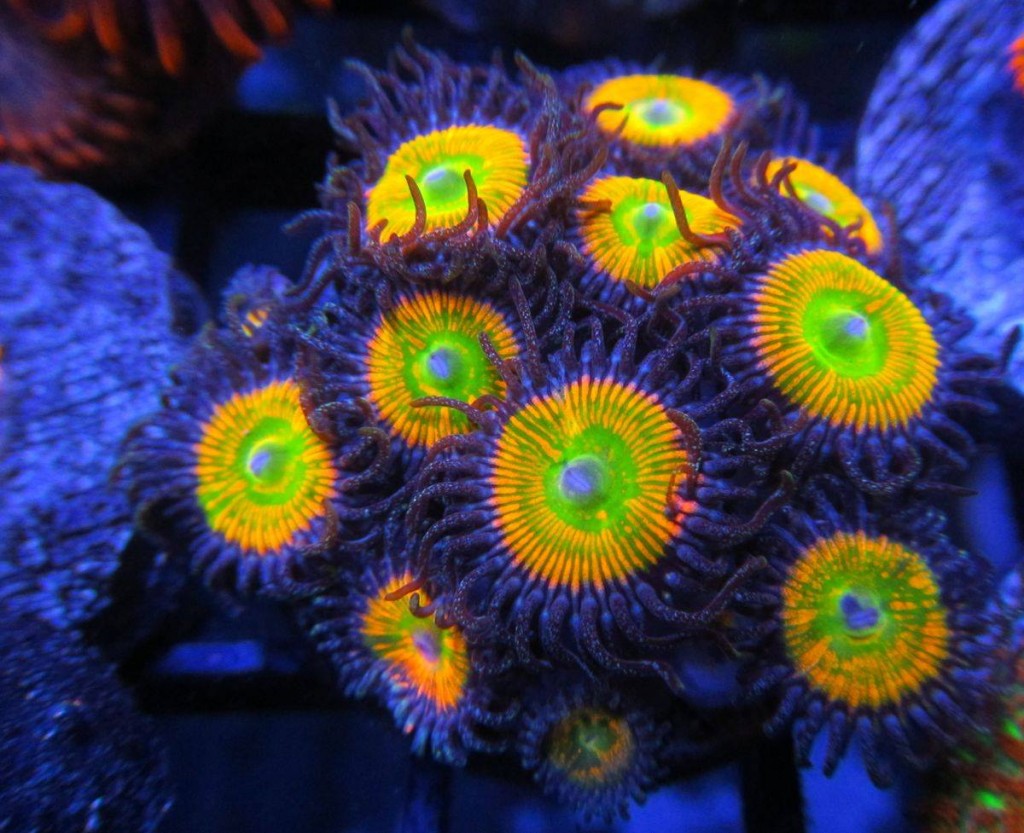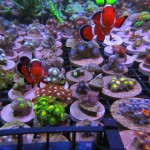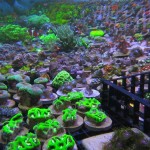In this hobby we see coral and invert phases come and go. From clams to chalices and even maxi mini anemones, it seems like they all go through a lot of initial hype then slowly decline in popularity. One of the mainstays in the hobby have been zoanthids and palythoas, which have been the craze for quite a while now. They have been in demand for what seems like an eternity and they do not appear to be getting less popular. Instead, it seems like they’re constantly on the rise.
Zoas and palys are highly favored in the hobby by both beginner and expert reefers alike. They don’t require much in terms of care like other specimens and they grow under many types of lighting from T5s to LEDs. Polyps grow at the bottom of the sand bed or on your highest rock. They don’t necessarily need to be target fed like other corals and they also do not require us to dose things like calcium. They survive in low or high flow. They grow in a “mat” like pattern, carpeting your rocks with vibrantly stunning colors. Some hobbyists generally keep zoa dominated aquariums or “Zoa gardens”. Their prices range anywhere from a couple of dollars per frag all the way up to $60+ dollars per polyp. Price usually depends on rarity and color just like any other coral.
Due to their popularity, quick growth, and ease of care, many zoanthids and palythoas are aquacultured. Meaning these corals have been grown in vendors aquariums and not collected from the wild. This means this coral has been adapted and already growing/thriving in environments like our own aquariums, giving these corals a greater chance of survival and giving you a chance to successfully see this coral grow into your aquarium.
- RK Brushfire Palys, Photo Credit: Reefkoi Corals
- RK Rasta Paly, Photo Credit: Reefkoi Corals
- Electric Oompa Loompas, Photo Credit: Reefkoi Corals
- Mandarin orange zoas, Photo credit: Reefkoi Corals
- Leprechauns, Photo Credit: Reefkoi Corals
- RK Sleepy hollow, Photo Credit: Reefkoi Corals
To get an insiders scoop on the market of zoas and palys, we sat down with our friend Chris at Reefkoi Corals to ask him a couple questions. Chris has been aquaculturing corals since 2007. He has seen corals come and go as they pass through their phases. He also has one big selection of polyps, so who better to answer the following questions?
AquaNerd: In your opinion why are polyps in such a hype right now?
ReefKoi “Because they are easy to grow, have amazing colors and patterns and are an easy way for even newbies to have the high end stuff.”
AquaNerd: Is it important to dose certain elements to see better results out of the growth of polyps?
ReefKoi “I can’t say if it helps, I have no scientific data, but I do think keeping your water at natural salt water levels is always a good way to keep a tank maintained.”
AquaNerd: What do you think about Vitamin C dosing for zoa/paly dominated tanks and the feedback people give that the polyps benefit from this?
ReefKoi “I haven’t tried it, I think it would change the colors maybe, but I honestly have never tried it nor see any reason to try it honestly.”
AquaNerd: Under what lighting have you seen the best growth out of polyps?
ReefKoi “Both LED and T5s here, I don’t run MH so I can’t speak for them. Seems that the brighter light helps most polyps grow faster and be brighter colored for sure.”
AquaNerd: What about water flow?
ReefKoi “I have always heard to blast them with flow but honestly low-medium flow works best for me, provided that detritus is not settling on them if it does I blow it off with a turkey baster manually as it is hard to get perfect flow in every part of any tank.”
AquaNerd: Have you seen a lot of morphing out of any of the polyps you have grown out?
ReefKoi “Not much actually, I see a lot of them come in that I see potential in but it never improves or changes that much unless the polyp already looked hot to begin with. I rarely see one come in brown and “color up” the way a brown chalice or some other coral can do is what I’m getting at. Now if I get a frag from someone that had it in a tank with water parameters that where way off or lighting way too low, then yes they morph.”
AquaNerd: Any special methods that you see the polyps growing best at?
ReefKoi “Well I’ve found that letting them grow to 12+ heads before re-fragging makes them grow faster, more aggressive fragging results in smaller babies and smaller adult polyps which is why a lot of high end polyps are sold as tiny single head frags I think. My 45 degree egg crate work well because the detritus can’t settle as easily on the polyps because of the angle, this idea has only been in use here for about 6-12 months so we are still deciding if it’s any better for growth. Regardless the frags look great on it and do grow off the plugs regularly.”
AquaNerd: What is the most expensive polyps that you have seen in the market?
ReefKoi “Krakatoas for sure!”
AquaNerd: Is there a polyp that is your favorite?
ReefKoi “That’s tough. I change my mind when new ones emerge but my Hallucinations are pretty much at the top of my favorites I’d have to say.”
AquaNerd: Is there a polyp that you see others mostly attracted to?
ReefKoi “I think if it wasn’t for the internet we’d all be in love with good ole cheap super bright polyps from Vietnam haha, in this hobby everyone wants what their buddies don’t have, I was the same way as a hobbyist and I think that a lot of what drives the price up to where it gets so high. That said I don’t blame anyone for pricing rarer corals high, $300 per polyp is actually not hat bad when it’s something that is very rare and by rare I mean like 3 people have them in the US. So if that was a coin or car or anything else you can bet the price would be sky high.”
- Photo Credit: ReefKoi Corals
- Photo Credit: ReefKoi Corals
- Photo Credit: ReefKoi Corals
- Photo Credit: ReefKoi Corals
- Photo Credit: ReefKoi Corals
Polyps by no means are very hard to keep. They are also one of the easiest corals to frag. Zoanthids where actually the coral I first fragged, but one thing is still true. No matter the price or how difficult it is for us to get them, us reefers are suckers for bright colored and expensive little polyps. A special thank you to Chris for sharing with us some great information and opinions. We leave you with some pictures of Chris’s 45 degree angled racks specially built to grow zoas and palys some of the hot polyps out there.


















Pingback: The Polyp Craze, a Look at Why Zoanthids and Palythoas are So Popular Even After All These Years - reefs.com()
Pingback: Joe's Apocalypse Paly is a Showstopper | AquaNerd()